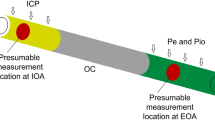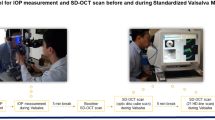Abstract
Objectives
To provide reference values of trans-laminar cribrosa pressure difference (TLCPD) and reveal the association of TLCPD with systemic biometric factors.
Methods
In this cross-sectional study, 526 quasi-healthy subjects (including 776 eyes) who required lumbar puncture for medical reasons were selected from 4915 neurology inpatients from 2019 to 2022. Patients with any diseases affecting intraocular pressure (IOP) or intracranial pressure (ICP) were excluded. The ICPs of all subjects were obtained by lumbar puncture in the left lateral decubitus position. IOP was measured in the seated position by a handheld iCare tonometer prior to lumbar puncture. TLCPD was calculated by subtracting ICP from IOP. Systemic biometric factors were assessed within 1 h prior to TLCPD measurement.
Results
The TLCPD (mean ± standard deviation) was 4.4 ± 3.6 mmHg, and the 95% reference interval (defined as the 2.5th–97.5th percentiles) of TLCPD was −2.27 to 11.94 mmHg. The 95% reference intervals for IOP and ICP were 10–21 and 6.25–15.44 mmHg, respectively. IOP was correlated with ICP (r = 0.126, p < 0.001). TLCPD was significantly negatively correlated with body mass index (r = −0.086, p = 0.049), whereas it was not associated with age, gender, height, weight, blood pressure, pulse, or waist and hip circumference.
Conclusions
This study provides reference values of TLCPD and establishes clinically applicable reference intervals for normal TLCPD. Based on association analysis, TLCPD is higher in people with lower BMI.
This is a preview of subscription content, access via your institution
Access options
Subscribe to this journal
Receive 18 print issues and online access
$259.00 per year
only $14.39 per issue
Buy this article
- Purchase on Springer Link
- Instant access to full article PDF
Prices may be subject to local taxes which are calculated during checkout



Similar content being viewed by others
Data availability
All data generated or analysed during this study are included in this published article and its supplementary information files.
References
Berdahl JP, Yu DY, Morgan WH. The translaminar pressure gradient in sustained zero gravity, idiopathic intracranial hypertension, and glaucoma. Med Hypotheses. 2012;79:719–24.
Yavin D, Luu J, James MT, Roberts DJ, Sutherland GR, Jette N, et al. Diagnostic accuracy of intraocular pressure measurement for the detection of raised intracranial pressure: meta-analysis: a systematic review. J Neurosurg. 2014;121:680–7.
Liu KC, Fleischman D, Lee AG, Killer HE, Chen JJ, Bhatti MT. Current concepts of cerebrospinal fluid dynamics and the translaminar cribrosa pressure gradient: a paradigm of optic disk disease. Surv Ophthalmol. 2020;65:48–66.
Ren R, Jonas JB, Tian G, Zhen Y, Ma K, Li S, et al. Cerebrospinal fluid pressure in glaucoma: a prospective study. Ophthalmology. 2010;117:259–66.
Lindén C, Qvarlander S, Jóhannesson G, Johansson E, Östlund F, Malm J, et al. Normal-tension glaucoma has normal intracranial pressure: a prospective study of intracranial pressure and intraocular pressure in different body positions. Ophthalmology. 2018;125:361–8.
Berdahl JP, Ferguson TJ, Samuelson TW. Periodic normalization of the translaminar pressure gradient prevents glaucomatous damage. Med Hypotheses. 2020;144:110258.
Berdahl JP, Fautsch MP, Stinnett SS, Allingham RR. Intracranial pressure in primary open angle glaucoma, normal tension glaucoma, and ocular hypertension: a case-control study. Invest Ophthalmol Vis Sci. 2008;49:5412–8.
Berdahl JP, Allingham RR, Johnson DH. Cerebrospinal fluid pressure is decreased in primary open-angle glaucoma. Ophthalmology. 2008;115:763–8.
Lee JWY, Chan PP, Zhang X, Chen LJ, Jonas JB. Latest developments in normal-pressure glaucoma: diagnosis, epidemiology, genetics, etiology, causes and mechanisms to management. Asia Pac J Ophthalmol (Philos). 2019;8:457–68.
Pircher A, Remonda L, Weinreb RN, Killer HE. Translaminar pressure in Caucasian normal tension glaucoma patients. Acta Ophthalmol. 2017;95:e524–31.
Wall M, White WN II. Asymmetric papilledema in idiopathic intracranial hypertension: prospective interocular comparison of sensory visual function. Invest Ophthalmol Vis Sci. 1998;39:134–42.
Radke PM, Rubinstein TJ, Hamilton SR, Jamil AL, Sires BS. The translaminar pressure gradient: papilledema after trabeculectomy treated with optic nerve sheath fenestration. J Glaucoma. 2018;27:e154–7.
Hoehn R, Mirshahi A, Hoffmann EM, Kottler UB, Wild PS, Laubert-Reh D, et al. Distribution of intraocular pressure and its association with ocular features and cardiovascular risk factors: the Gutenberg Health Study. Ophthalmology. 2013;120:961–8.
Tomoyose E, Higa A, Sakai H, Sawaguchi S, Iwase A, Tomidokoro A, et al. Intraocular pressure and related systemic and ocular biometric factors in a population-based study in Japan: the Kumejima study. Am J Ophthalmol. 2010;150:279–86.
Fleischman D, Berdahl JP, Zaydlarova J, Stinnett S, Fautsch MP, Allingham RR. Cerebrospinal fluid pressure decreases with older age. PLoS One. 2012;7:e52664.
Malm J, Jacobsson J, Birgander R, Eklund A. Reference values for CSF outflow resistance and intracranial pressure in healthy elderly. Neurology. 2011;76:903–9.
Price DA, Harris A, Siesky B, Mathew S. The influence of translaminar pressure gradient and intracranial pressure in glaucoma: a review. J Glaucoma. 2020;29:141–6.
Morgan WH, Yu DY, Alder VA, Cringle SJ, Cooper RL, House PH, et al. The correlation between cerebrospinal fluid pressure and retrolaminar tissue pressure. Invest Ophthalmol Vis Sci. 1998;39:1419–28.
Balaratnasingam C, Morgan WH, Johnstone V, Pandav SS, Cringle SJ, Yu DY. Histomorphometric measurements in human and dog optic nerve and an estimation of optic nerve pressure gradients in human. Exp Eye Res. 2009;89:618–28.
Jonas JB, Wang N, Wang YX, You QS, Xie X, Yang D, et al. Body height, estimated cerebrospinal fluid pressure and open-angle glaucoma. The Beijing Eye Study 2011. PLoS One. 2014;9:e86678.
Jonas JB, Nangia V, Wang N, Bhate K, Nangia P, Nangia P, et al. Trans-lamina cribrosa pressure difference and open-angle glaucoma. The central India eye and medical study. PLoS One. 2013;8:e82284.
Bild DE, Bluemke DA, Burke GL, Detrano R, Diez Roux AV, Folsom AR, et al. Multi-Ethnic Study of Atherosclerosis: objectives and design. Am J Epidemiol. 2002;156:871–81.
Lee SC, Lueck CJ. Cerebrospinal fluid pressure in adults. J Neuroophthalmol. 2014;34:278–83.
Norager NH, Olsen MH, Pedersen SH, Riedel CS, Czosnyka M, Juhler M. Reference values for intracranial pressure and lumbar cerebrospinal fluid pressure: a systematic review. Fluids Barriers CNS. 2021;18:19.
Vishwaraj CR, Kavitha S, Venkatesh R, Shukla AG, Chandran P, Tripathi S. Neuroprotection in glaucoma. Indian J Ophthalmol. 2022;70:380–5.
Downs JC. Neural coupling of intracranial pressure and aqueous humour outflow facility: a potential new therapeutic target for intraocular pressure management. J Physiol. 2020;598:1429–30.
Zhao J, Solano MM, Oldenburg CE, Liu T, Wang Y, Wang N, et al. Prevalence of normal-tension glaucoma in the chinese population: a systematic review and meta-analysis. Am J Ophthalmol. 2019;199:101–10.
Iwase A, Suzuki Y, Araie M, Yamamoto T, Abe H, Shirato S, et al. The prevalence of primary open-angle glaucoma in Japanese: the Tajimi Study. Ophthalmology. 2004;111:1641–8.
Jonas JB, Wang N, Yang D, Ritch R, Panda-Jonas S. Facts and myths of cerebrospinal fluid pressure for the physiology of the eye. Prog Retin Eye Res. 2015;46:67–83.
Liu H, Yang D, Ma T, Shi W, Zhu Q, Kang J, et al. Measurement and associations of the optic nerve subarachnoid space in normal tension and primary open-angle glaucoma. Am J Ophthalmol. 2018;186:128–37.
Wang N, Xie X, Yang D, Xian J, Li Y, Ren R, et al. Orbital cerebrospinal fluid space in glaucoma: the Beijing intracranial and intraocular pressure (iCOP) study. Ophthalmology. 2012;119:2065–73. e2061
Killer HE, Pircher A. Normal tension glaucoma: review of current understanding and mechanisms of the pathogenesis. Eye (Lond). 2018;32:924–30.
Li Z, Yang Y, Lu Y, Liu D, Xu E, Jia J, et al. Intraocular pressure vs intracranial pressure in disease conditions: a prospective cohort study (Beijing iCOP study). BMC Neurol. 2012;12:66.
Hou R, Zhang Z, Yang D, Wang H, Chen W, Li Z, et al. Pressure balance and imbalance in the optic nerve chamber: The Beijing Intracranial and Intraocular Pressure (iCOP) Study. Sci China Life Sci. 2016;59:495–503.
Ren R, Zhang X, Wang N, Li B, Tian G, Jonas JB. Cerebrospinal fluid pressure in ocular hypertension. Acta Ophthalmol. 2011;89:e142–148.
Wakerley BR, Warner R, Cole M, Stone K, Foy C, Sittampalam M. Cerebrospinal fluid opening pressure: the effect of body mass index and body composition. Clin Neurol Neurosurg. 2020;188:105597.
Pasquale LR, Willett WC, Rosner BA, Kang JH. Anthropometric measures and their relation to incident primary open-angle glaucoma. Ophthalmology. 2010;117:1521–9.
Acknowledgements
The authors thank AiMi Academic Services (www.aimieditor.com) for the English language editing and review services.
Funding
The study was funded by the National Natural Science Foundation of China (82130029). The funding organization had no role in the design or conduct of this research.
Author information
Authors and Affiliations
Contributions
NLW and JWW contributed to the design, acquisition of funding and general supervision of the research group. RQP and DTL contributed to the design, acquired data, analysis of results and drafting of the manuscript. XMD, XYL, LHG, JC, YJ and YPW contributed to the acquired data and advised on the research. KC, TMR and YC contributed to the data analysis.
Corresponding authors
Ethics declarations
Competing interests
The authors declare no competing interests.
Additional information
Publisher’s note Springer Nature remains neutral with regard to jurisdictional claims in published maps and institutional affiliations.
Supplementary information
Rights and permissions
Springer Nature or its licensor (e.g. a society or other partner) holds exclusive rights to this article under a publishing agreement with the author(s) or other rightsholder(s); author self-archiving of the accepted manuscript version of this article is solely governed by the terms of such publishing agreement and applicable law.
About this article
Cite this article
Pang, R., Lin, D., Di, X. et al. Reference values for trans-laminar cribrosa pressure difference and its association with systemic biometric factors. Eye 37, 2240–2245 (2023). https://doi.org/10.1038/s41433-022-02323-9
Received:
Revised:
Accepted:
Published:
Issue Date:
DOI: https://doi.org/10.1038/s41433-022-02323-9



